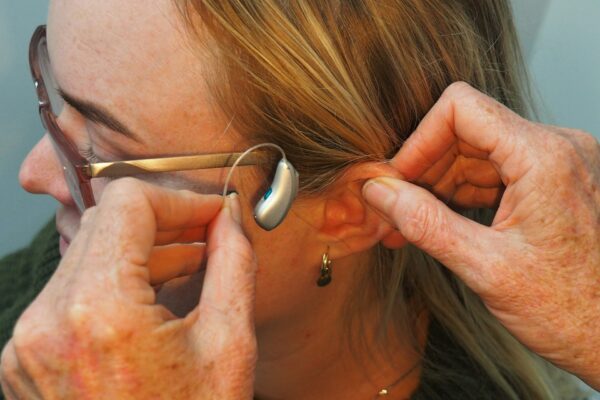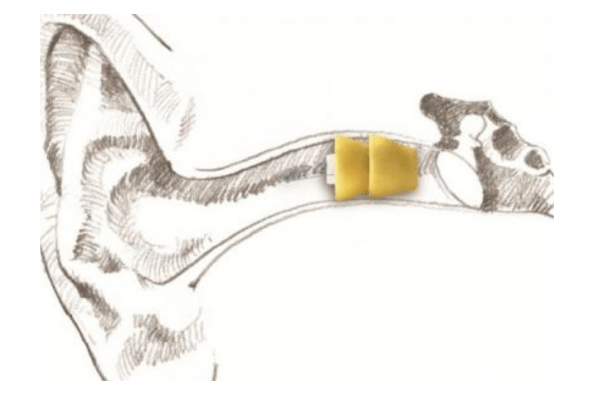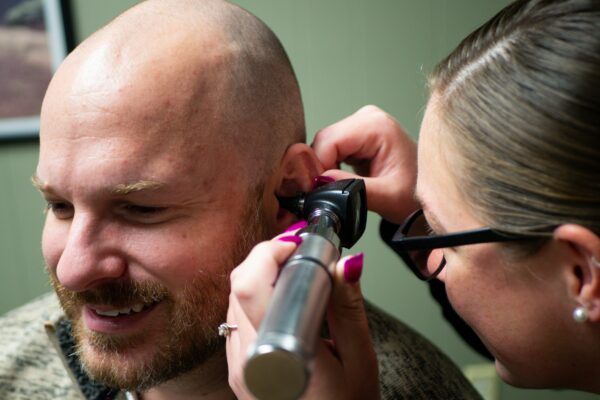
Hearing aids have evolved enormously in recent years, offering people more choices than ever before. For many, the decision between hidden hearing aids and behind-the-ear (BTE) devices doesn’t just consider performance, but also comfort, lifestyle, and visibility. With cutting-edge designs, both options serve distinct needs, but knowing which is right for you requires a clear understanding of their differences.
This guide explores the key distinctions between hidden hearing aids and behind-the-ear hearing aids, answering vital questions like how much is a hidden hearing aid, what brand of hearing aid does Hidden Hearing use, and which style best matches your hearing needs.
Hidden hearing aids, sometimes referred to as hearing aids hidden or completely-in-the-canal (CIC) models, are designed to fit discreetly within the ear canal. They are tailored to the user’s ear, offering a near-invisible solution for those who prefer a subtle hearing device.
The best hidden hearing aids provide natural sound quality, minimal visibility, and a comfortable fit. They are ideal for individuals with mild to moderate hearing loss who want discretion without compromising on clarity.
Behind-the-ear hearing aids, commonly called BTE devices, are the most recognised type of hearing aid. These models sit comfortably behind the ear and are connected via thin tubing to an ear mould or dome placed in the ear canal.
BTE hearing aids offer more room for powerful components, such as larger batteries, directional microphones, and advanced processors. As a result, behind ear hearing aids are well suited for moderate to severe hearing loss and for those who value robust performance.
While both types aim to improve hearing clarity, the difference largely comes down to design, visibility, and suitability for different levels of hearing loss. Hidden hearing aids are known for their discretion, while behind-the-ear devices typically offer more features and flexibility.
Hidden hearing aids are placed entirely within the ear, making them practically invisible. In contrast, behind the ears hearing aids rest outside the ear, but modern designs are smaller and more subtle than ever before.
For many people, the appeal of hidden hearing aids lies in their invisibility. These devices offer the freedom to wear hearing aids without drawing attention, which can improve confidence and reduce the stigma often associated with hearing loss.
The best hidden hearing aid models also offer a natural sound experience because they sit closer to the eardrum. Their discreet placement means they don’t interfere with glasses or masks, which can be particularly useful for active lifestyles.
Despite being more visible, behind-the-ear hearing aids offer an impressive range of benefits. Thanks to their size, they can house larger processors and batteries, resulting in better amplification, longer battery life, and more features.
Behind the ear rechargeable hearing aids are also becoming increasingly popular, offering a convenient, environmentally friendly alternative to replaceable batteries. Their larger controls and parts make them easier to handle, especially for users with dexterity issues.
Although invisible and discreet, hidden hearing aids have limitations. Due to their small size, they may lack some of the advanced features available in BTE models. For example, they may not support Bluetooth streaming or directional microphones.
Another factor is battery life. Hidden hearing aid batteries are smaller and typically last between three and seven days. Users must be prepared for more frequent replacements.
In terms of cost, how much do hidden hearing aids cost? They tend to be more expensive due to their custom fit and compact technology, making them a bigger investment.
While modern BTE hearing aids are sleeker than ever, their visibility can still be a concern for some. The tubing and outer casing can be noticeable, especially for those with shorter hair.
Behind the ear or in the ear hearing aids can also cause initial discomfort, particularly for new users. Adjusting to wearing something behind the ear can take time.
Without question, hidden hearing aids are the most discreet. They are designed to sit entirely within the ear canal, making them virtually invisible to others.
That said, behind-the-ear designs have improved dramatically. Slim tube designs, skin-toned colours, and compact casings mean that even traditional models are far less noticeable than they once were. For those seeking the smallest behind the ear hearing aid, many BTE options now come in extremely discreet formats.
In terms of sound quality, both styles can deliver excellent results. However, hidden hearing aids are best for mild to moderate hearing loss, offering a natural listening experience in quiet environments.
Behind-the-ear hearing aids often perform better in noisy settings due to features like directional microphones and noise reduction. They are more adaptable for various hearing levels and tend to provide a broader dynamic range of amplification.
Cost is a significant factor in choosing a hearing aid. Hidden hearing aids usually carry a higher price tag due to their customisation, size, and advanced technology. If you’re asking how much is a hidden hearing aid, expect to pay more than a standard BTE model.
Hidden hearing aid prices vary widely depending on brand, features, and aftercare services. Brands like Hidden Hearing offer both styles but often recommend premium models tailored to the user’s needs.
Hidden hearing aids typically use very small batteries that require frequent changes. Their compact design can also make maintenance a bit more fiddly. These devices need to be kept dry and clean to avoid moisture damage.
In contrast, BTE hearing aids often support rechargeable options and have longer-lasting batteries. They are also easier to clean and maintain, which is ideal for those with limited dexterity or vision challenges.
Hidden hearing aids are perfect for individuals who prioritise discretion and have mild to moderate hearing loss. They suit people who are active, style-conscious, or new to hearing aids and wish to keep their devices low-profile.
They are also ideal for those without complex hearing needs and who feel confident changing small batteries and managing smaller components.
Behind-the-ear devices are best for users who need more power or additional features. They are particularly suitable for individuals with moderate to severe hearing loss or those who prefer a device that is easier to handle and maintain.
With the availability of behind the ear rechargeable hearing aids and open-fit designs, BTE options continue to offer versatility, convenience, and robust performance.
Choosing between hidden hearing aids and behind-the-ear models isn’t about which is better overall, it’s about what’s better for you. Consider your hearing needs, lifestyle, comfort preferences, and budget. If discretion is your top priority, hidden hearing aids may be the right solution. If you need more features, battery life, or support for severe hearing loss, a BTE device might be the ideal match.
At Sussex Audiology Centre, we’re here to guide you through the process and help you find the perfect fit. With access to the latest technology and leading hearing aid brands, we ensure your hearing solution is tailored entirely to you.
What are hidden hearing aids?
Hidden hearing aids are designed to be discreet, fitting deep inside the ear canal or designed in such a way that they are barely noticeable. They offer a nearly invisible solution for individuals who prefer not to have visible hearing devices.
Are behind-the-ear hearing aids better than hidden hearing aids?
It depends on your hearing needs. Behind-the-ear (BTE) hearing aids generally offer more power, features, and battery life, making them ideal for more severe hearing loss. Hidden hearing aids are better suited for those with mild to moderate hearing loss who prioritise discretion and aesthetics.
How much do hidden hearing aids cost?
Hidden hearing aids typically cost more than standard BTE models due to their compact technology and custom fitting. Prices vary depending on the brand, technology level, and specific features chosen.
What brand of hearing aids does Hidden Hearing use?
Hidden Hearing works with a range of leading hearing aid brands, offering both hidden and traditional models from manufacturers known for their quality and innovation, ensuring customers have access to the latest technology.
Can behind-the-ear hearing aids be discreet?
Yes, modern behind-the-ear devices are far sleeker and more discreet than older models. Many are designed with slim tubing and subtle colours that blend with hair or skin tone, making them much less noticeable.
Which is the best choice for me: hidden hearing aids or behind-the-ear devices?
The best choice will depend on your level of hearing loss, your lifestyle, and your preference for visibility. A professional audiologist can assess your needs and recommend the best type of hearing aid to ensure you get the most benefit and comfort.
Your perfect hearing solution starts with a conversation. Whether you’re interested in hidden hearing aids or want to explore the latest behind-the-ear hearing aids, Sussex Audiology Centre is here to guide you.
Contact us today and take the first step towards a clearer, more peaceful listening experience.

25 April 2024

10 May 2022

30 December 2025
Fields marked with an * are required
“I’d like to start by thanking Rosanne for her expertise and service over the
years – the best hearing aids in the world are nothing without an expert
audiologist on hand to manage them.
December ‘24, I decided to upgrade my aids to Phonak Audéo I90-Sphere,
and the experience has been both amazing and quite emotional.
I am now able hear speech far more clearly, even in very noisy situations, as
never before – the “Spheric” program is unbelievably good. Birdsong is a joy,
and I can enjoy my music again but crucially, I am far more enthusiastic
about attending social occasions, family gatherings, meetings, the cinema
etc.
I’ve had them six months now and I’m still absolutely delighted. Many
thanks to Rosanne and Sussex Audiology Centre.”
Roy Groom
Patient Review
“I was nervous about getting a hearing test, but the audiologists made me feel at ease. The results were explained clearly, and I felt well cared for.”
David L, Crawley
Google Review
“The team at Sussex Audiology Centre was incredibly professional and friendly. My at-home hearing test was convenient and thorough. Highly recommended!”
Sarah M, Crawley
Google Review
“Lovely and friendly. Helped me amazingly remove my wax buildup comfortably. And offered to clean my other ear free of charge as it was only ever so slightly blocked. Highly recommend visiting here for your ear troubles.”
Scott Pullen
Google Review
© 2026 Sussex Audiology | Privacy Policy | Late Fees
Up front payment is required at the time of booking, card payment can be taken via telephone.
If wax has not been sufficiently softened prior to the appointment the consultation fee remains payable. This will be confirmed via video otoscopy.
Appointments will not be made within 7 days to allow sufficient time for ear drops to take effect and maximise the efficacy of the appointment. Olive oil ear drops (Earol) should be applied morning and evening for the 7 days prior to the appointment unless a valid reason why this is not possible (ie. Perforated ear drum).
If the appointment is cancelled within 24 hours of the visit a £90 fee will be charged.
If the patient is not present or not able to be seen a £90 appointment fee will be charged.
Appointments will be within a 2 hour window, the audiologist will call on route to confirm arrival 30 mins prior.
Patient must be ready for their appointment, sitting upright in a chair with access to both ears. Patients in care homes must be able to sit in a non-high winged chair (normal high backed chair is suitable).
You will be required to read and sign (if able) a treatment consent form at the time of your appointment.
If you would like any information regarding our services or products please get in touch.